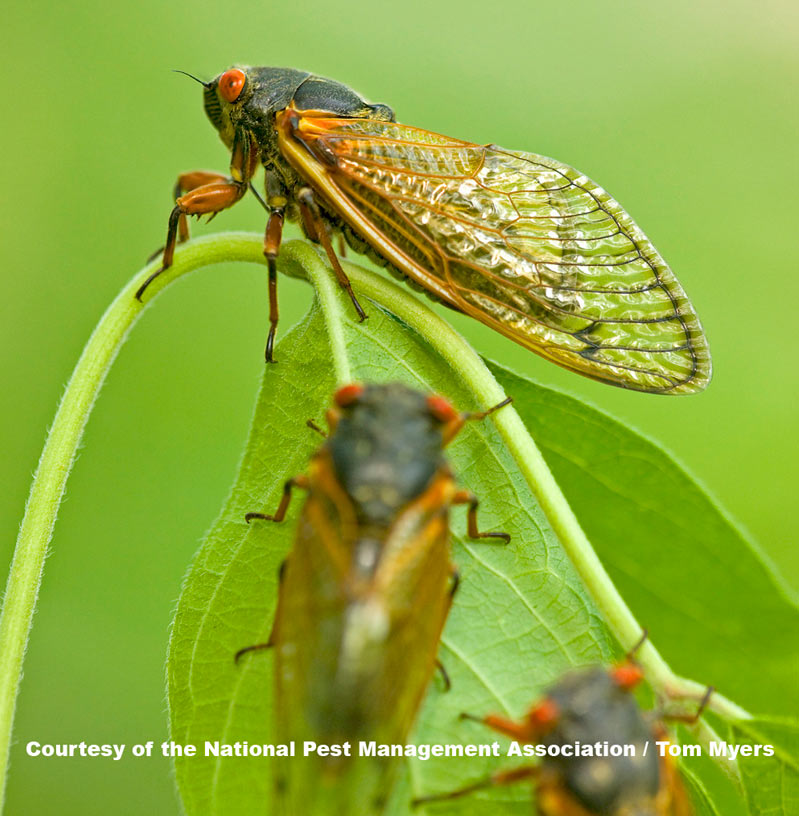17-Year Cicadas Are Buzzing In! What to Expect

The U.S. Northeast is about to be snowed under by cicadas. Don't worry, though, it's normal. The pesky invasion is just so unusual that people tend to forget about it.
After 17 years underground, the so-called "Brood II" cicadas are about to have their time in the sun. Millions of these root-sucking insects will come out into the open and spend four to six weeks calling for mates, mating and then laying eggs for the next generation.
This brief overpopulation of cicadas in April and May is supposed to overwhelm what predators are able to eat, explained Jim Fredericks, the National Pest Management Association's director of technical services. [Ewwww! 6 Crazy Facts About Cicadas]
"Bird species, raccoons, possums, foxes and whatever can get their mouths on these things, can eat their fill and have no impact on the population," Fredericks said.
These insects cause no harm to humans or to property, although occasionally a car parked under a cicada-infested tree could get covered in small droppings.
"They are literally everywhere, crawling over every tree, every building, everywhere. It's an amazing number of individual animals," said Chris Hartley, an entomologist at the Sophia M. Sachs Butterfly House of the Missouri Botanical Garden.
Hormones drive the cycle
Sign up for the Live Science daily newsletter now
Get the world’s most fascinating discoveries delivered straight to your inbox.
Cicadas (erroneously called locusts) are large, dark-backed insects related to aphids and leafhoppers. They typically grow to about 2 inches (5 centimeters) in size, and they are loud: their calls can reach to 100 decibels, about the same noise intensity as a nearby motorcycle.
The United States hosts several cicada species. Many of them emerge every year, but there are also distinct populations that only mature every 13 or 17 years. (Brood II is only one of several 17-year broods, but its location in the heavily populated northeastern United States, east of the Great Plains, means it is getting a lot of media attention.)
The prime number makes it hard for predators to predict when the cicadas will emerge, biologists believe.
After cicadas emerge from the ground and mate, the females lay eggs at the edges of tree branches, which can damage the branches on a small tree. A single female can produce hundreds of eggs across several batches.
When the larvae hatch, they crawl down the trunk and burrow into the soil to feed on plant and tree roots. The larvae have mouths that behave "like a hypodermic needle," Fredericks said, which sticks into tree tissue and takes the juices out.
The larvae go through several stages of youth. In annual cicadas, these stages pass quickly, while 13- or 17-year cicadas see a much more prolonged childhood.
"In the case of these cicadas, they are triggered to not produce the hormones essential for becoming an adult until those numbers of years have passed," Hartley said.
"It's all in their genes and their development, and that is the adaptation that they have acquired to achieve these mass emergences."
Few underground life studies
It's difficult to study the cicada cycle as much of it takes place underground. Scientists think intense competition goes on when the cicadas are still nymphs.
"Most mortality takes place in the first or second [nymph stage]," said Chris Simon, a cicada researcher at the University of Connecticut. "There's competition for feeding space underground."
The cicadas may die in battle, fighting with each other for food, but nobody knows that for sure yet.
"They have digging claws that can dig through hard dirt, so they might be able to actually kill each other," Simon said. "We don't know because it's hard to watch them underground."
The 13- and 17-year cicadas are the only ones that spend such a long period as juveniles, except for insects that "diapause," or wait for conditions to be ideal before emerging from hibernation.
Some beetles, for example, have been recorded emerging from furniture imported from Asia decades before, she said.
Follow Elizabeth Howell @howellspace. Follow LiveScience @livescience, Facebook & Google+. Original article on LiveScience.com.

Elizabeth Howell was staff reporter at Space.com between 2022 and 2024 and a regular contributor to Live Science and Space.com between 2012 and 2022. Elizabeth's reporting includes multiple exclusives with the White House, speaking several times with the International Space Station, witnessing five human spaceflight launches on two continents, flying parabolic, working inside a spacesuit, and participating in a simulated Mars mission. Her latest book, "Why Am I Taller?" (ECW Press, 2022) is co-written with astronaut Dave Williams.










